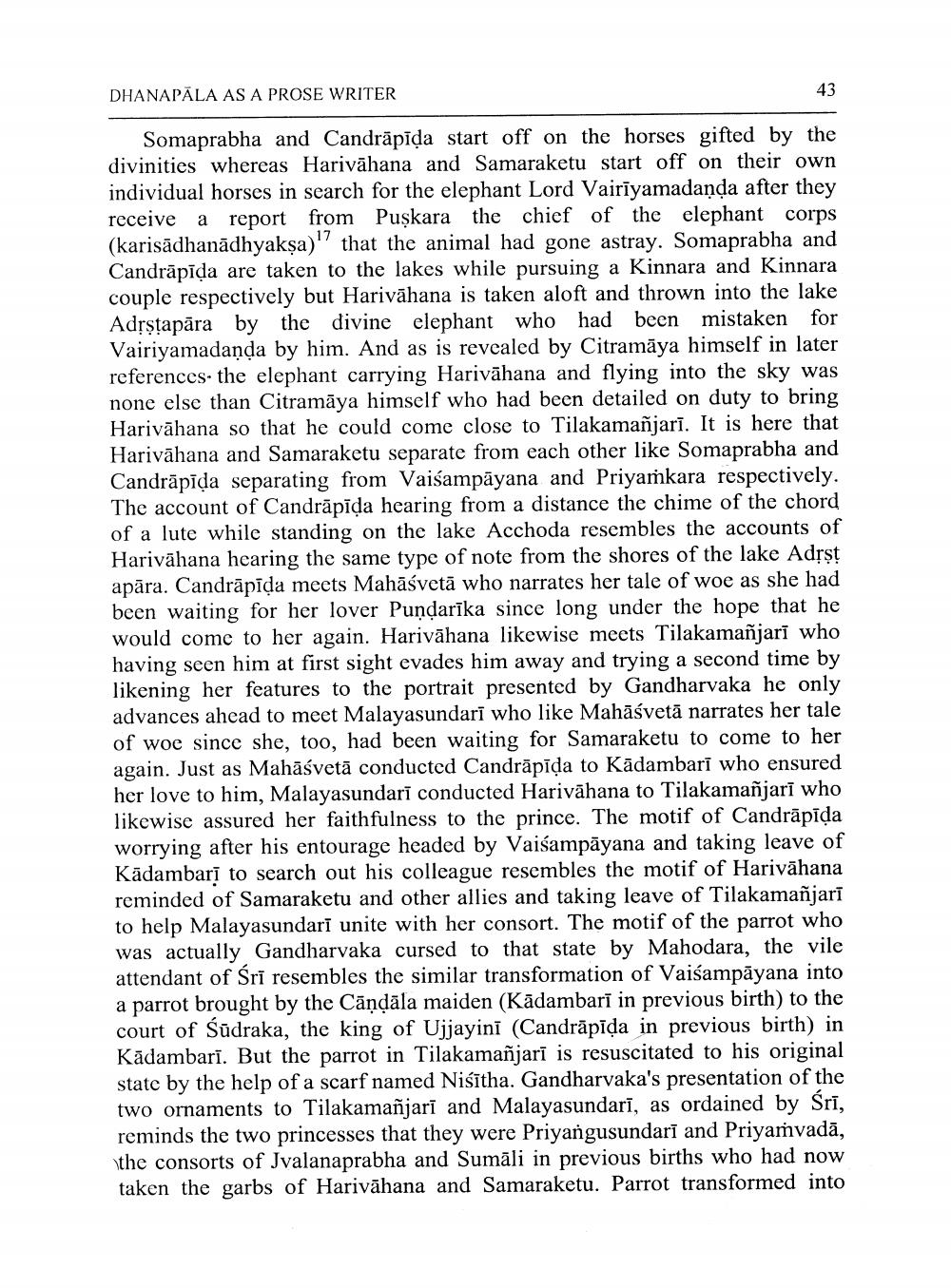________________
DHANAPALA AS A PROSE WRITER
Somaprabha and Candrāpīda start off on the horses gifted by the divinities whereas Harivāhana and Samaraketu start off on their own individual horses in search for the elephant Lord Vairīyamadanda after they receive a report from Puskara the chief of the elephant corps (karisādhanādhyaksa)" that the animal had gone astray. Somaprabha and Candrāpīda are taken to the lakes while pursuing a Kinnara and Kinnara couple respectively but Harivāhana is taken aloft and thrown into the lake Adrstapāra by the divine elephant who had been mistaken for Vairiyamadanda by him. And as is revealed by Citramāya himself in later references the elephant carrying Harivāhana and flying into the sky was none else than Citramāya himself who had been detailed on duty to bring Harivāhana so that he could come close to Tilakamañjarī. It is here that Harivāhana and Samaraketu separate from each other like Somaprabha and Candrāpīda separating from Vaišampāyana and Priyamkara respectively. The account of Candrāpida hearing from a distance the chime of the chord of a lute while standing on the lake Acchoda resembles the accounts of Harivāhana hearing the same type of note from the shores of the lake Adrst apāra. Candrāpida meets Mahāśvetā who narrates her tale of woe as she had been waiting for her lover Pundarīka since long under the hope that he would come to her again. Harivāhana likewise meets Tilakamañjarī who having seen him at first sight evades him away and trying a second time by likening her features to the portrait presented by Gandharvaka he only advances ahead to meet Malayasundarī who like Mahāśvetā narrates her tale of woe since she, too, had been waiting for Samaraketu to come to her again. Just as Mahāśvetā conducted Candrāpīda to Kādambarī who ensured her love to him, Malayasundari conducted Harivāhana to Tilakamañjarī who likewise assured her faithfulness to the prince. The motif of Candrāpīda worrying after his entourage headed by Vaišampāyana and taking leave of Kādambarī to search out his colleague resembles the motif of Harivāhana reminded of Samaraketu and other allies and taking leave of Tilakamañjarī to help Malayasundarī unite with her consort. The motif of the parrot who was actually Gandharvaka cursed to that state by Mahodara, the vile attendant of Sri resembles the similar transformation of Vaišampāyana into a parrot brought by the Cāņdāla maiden (Kādambarī in previous birth) to the court of Sūdraka, the king of Ujjayinī (Candrāpīda in previous birth) in Kādambari. But the parrot in Tilakamañjarī is resuscitated to his original state by the help of a scarf named Niśītha. Gandharvaka's presentation of the two ornaments to Tilakamañjarī and Malayasundarī, as ordained by Srī, reminds the two princesses that they were Priyangusundarī and Priyamvadā, the consorts of Jvalanaprabha and Sumāli in previous births who had now taken the garbs of Harivāhana and Samaraketu. Parrot transformed into




